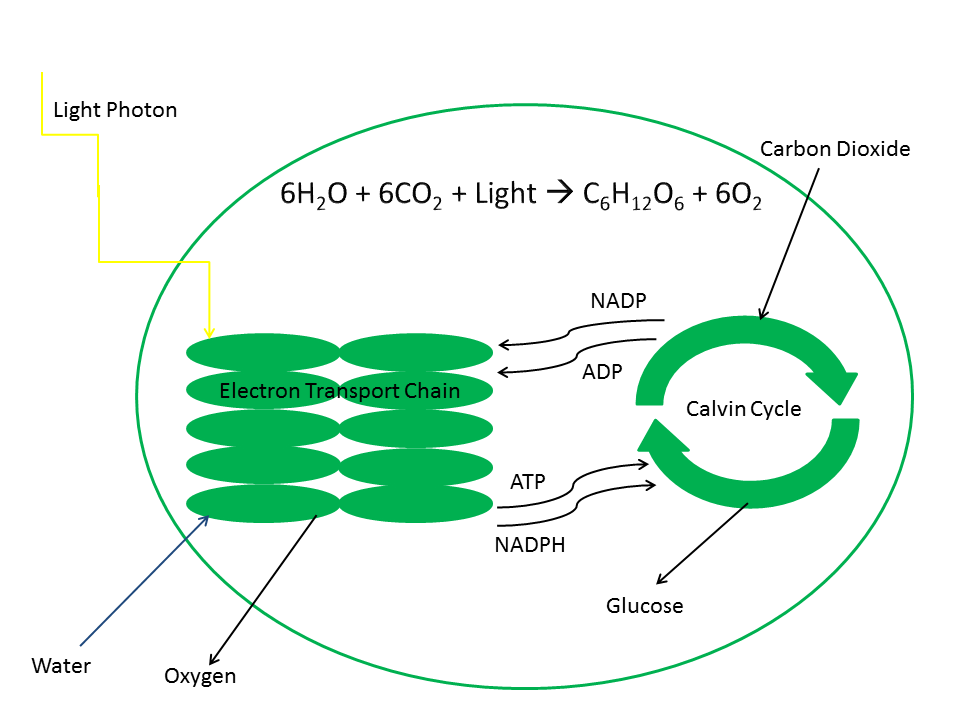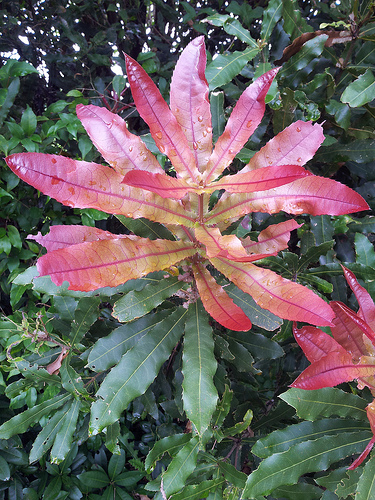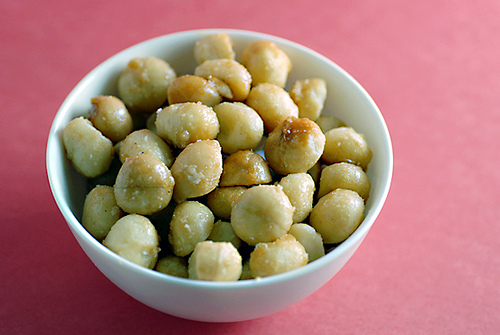Nutrition: How to get energy
Making the food:
Similar to most plants, the Macadamia
tetraphylla is an autotroph, or it makes its own food
(there are some crazy plants that actually eat things though,
check out the
Venus Fly Trap if you're interested). It acquires its food via
photosynthesis.
Since this is not an introductory biology class, I will
just quickly summarize what photosynthesis is and how this helps
the plant obtain nutrition (more info on photosynthesis
here).
First, the chlorophyll in the plant absorbs light photons and
excites electrons which go through a chain of enzymes helping to
generate energy. From this generated energy, some of it is
used by the plant to take inorganic carbon (in the form of CO2)
and turn it into organic carbon in the form of sugars
(carbohydrates). These sugars are then transported from
the leaves throughout the entire plant via phloem. The
phloem carry the sugars and other nutrients to every part of the
plant.

Breaking the food down:
Now most people know that plants undergo photosynthesis.
However, what a good portion of people are oblivious of is the
fact that plants also undergo cellular respiration just like you
and me!* So, after the plant is done creating some energy
and carbohydrates via photosynthesis, it stores the extra sugars
as starch. The starch is stored within the cells until the
plant needs more energy. From there, cellular respiration
takes place and the starch is broken down, glucose molecule by
glucose molecule.
*If you didn't know this, then you learn something everyday.
If you did know this, then bravo.
Getting the ingredients:
The inorganic carbon that the plant takes in during
photosynthesis comes from the carbon dioxide in our atmosphere.
The CO2 enters through the stomata of the leaves and then enters
the cells of the
 mesophyll via diffusion. Water is
obtained through the web of roots beneath the surface of the
ground (good picture of roots on
Adaptation page). The roots take in the water, as well as other
vital nutrients, and transport the H2O via xylem. The
xylem are the vascular tissue that carry water and nutrients
within the plant. Some of the transported nutrients that
are vital to the health of the plant are: calcium, phosphorous,
nitrogen, and potassium. These are generally taken in
through the roots. Sometimes, mutualistic mycorrhizal
fungi are present. These fungi help in the collection of
more water and nutrients for the plant. A great site to
help learn/see all the types of fungi is
Dr. Volk's Fungi Website.
mesophyll via diffusion. Water is
obtained through the web of roots beneath the surface of the
ground (good picture of roots on
Adaptation page). The roots take in the water, as well as other
vital nutrients, and transport the H2O via xylem. The
xylem are the vascular tissue that carry water and nutrients
within the plant. Some of the transported nutrients that
are vital to the health of the plant are: calcium, phosphorous,
nitrogen, and potassium. These are generally taken in
through the roots. Sometimes, mutualistic mycorrhizal
fungi are present. These fungi help in the collection of
more water and nutrients for the plant. A great site to
help learn/see all the types of fungi is
Dr. Volk's Fungi Website.
Morphology aiding in nutrition:
The leaves of the Macadamia are very broad and
spread out. This helps in more surface area
exposed to the sunlight, allowing for the increased
number of photons to be absorbed, which allows for
as many as possible chloroplasts to be used.
This would result in more sugar. Therefore,
the morphological features of the leaves of the
Macadamia tetraphylla greatly increase its
photosynthetic abilities. Also, the vast root
systems allows for a lot of nutrient uptake, which
is needed for the plant for proper nutrition.
Nutrition to us:
In addition to the plant itself getting energy, we, as
humans, can
obtain energy from the Macadamia
tetraphylla. The edible nut that is now
commercially produced is high in calcium,
phosphorus, iron, vitamin B, protein, and (healthly)
fat. Moreover, not only is the nut very
healthy, but it is also very delicious. There
are many uses for the macadamia nut, including one
of my favorite cookie recipes (if you're interested
in the recipe I have it written down under the
Facts
section). Along with the cookies, macadamia
nuts are eaten either raw or cooked, and are used in
foods from cakes and ice cream, to flour, to an edible oil. As of now, the Macadamia nut is a
sustainable food source due to cultivation (see
Reproduction).
edible oil. As of now, the Macadamia nut is a
sustainable food source due to cultivation (see
Reproduction).
We are not, however, the only organisms that eat the
Macadamia nut. Many small rodents and other
animals, such as squirrels, rabbits, and many birds,
eat these nuts because of their taste and high
nutrition. Animals that incorporate these nuts
into their diets are receiving a very high and
nutritional food source, which helps them in their
life cycles. Another highly eaten nut is the
Brazil Nut. I would recommend you check it
out!
Continue on to
Reproduction!